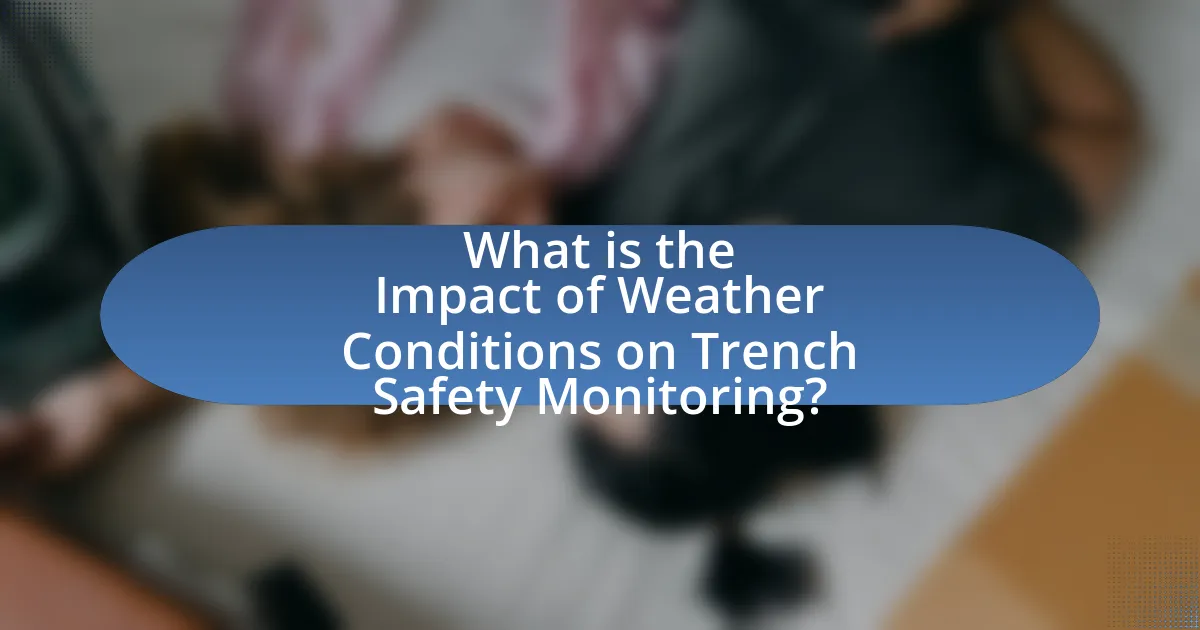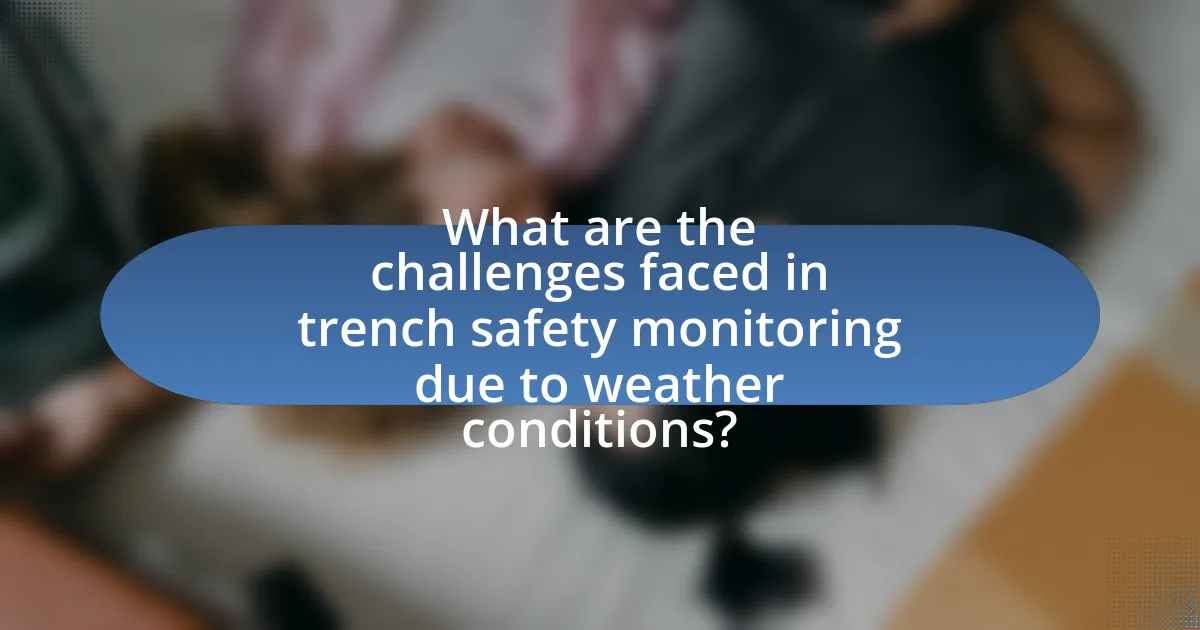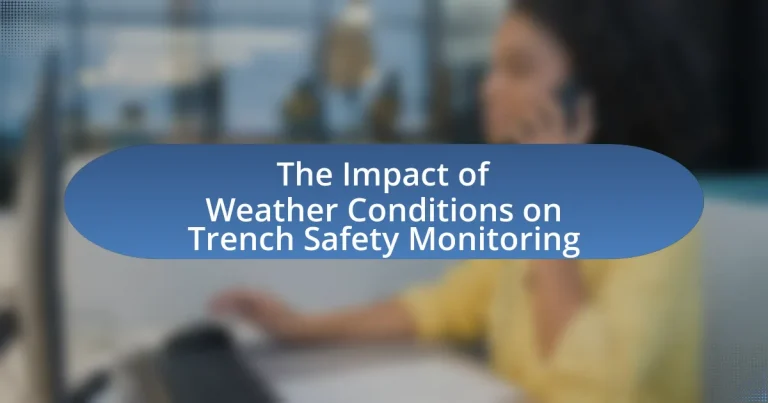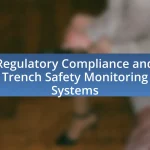The article focuses on the impact of weather conditions on trench safety monitoring, emphasizing how factors such as rainfall, temperature fluctuations, and wind speed affect soil stability and worker safety. It highlights the necessity of continuous monitoring and the implementation of safety protocols to mitigate risks associated with adverse weather, including trench collapses and worker injuries. The article also discusses specific methods for monitoring trench conditions, the role of technology in enhancing safety, and best practices for training workers to respond effectively to weather-related hazards. Additionally, it outlines the challenges posed by extreme weather events and the importance of communication and contingency planning in ensuring safety during trench operations.

What is the Impact of Weather Conditions on Trench Safety Monitoring?
Weather conditions significantly impact trench safety monitoring by influencing soil stability, visibility, and worker safety. For instance, heavy rainfall can lead to soil saturation, increasing the risk of trench collapses due to reduced cohesion in the soil. According to the Occupational Safety and Health Administration (OSHA), wet conditions can exacerbate hazards, necessitating more frequent monitoring and adjustments to safety protocols. Additionally, extreme temperatures can affect the physical condition of workers, impairing their ability to respond to emergencies effectively. Therefore, understanding and adapting to weather conditions is crucial for maintaining safety in trench operations.
How do weather conditions influence trench safety?
Weather conditions significantly influence trench safety by affecting soil stability, visibility, and worker exposure to hazards. For instance, heavy rainfall can lead to soil saturation, increasing the risk of trench collapse due to reduced cohesion. According to the Occupational Safety and Health Administration (OSHA), wet conditions can cause soil to become unstable, necessitating additional safety measures such as shoring or sloping. Additionally, extreme temperatures can impact worker performance and increase the likelihood of heat-related illnesses or hypothermia, further compromising safety. Therefore, monitoring weather conditions is essential for implementing appropriate safety protocols in trench work.
What specific weather factors affect trench safety monitoring?
Specific weather factors that affect trench safety monitoring include rainfall, temperature fluctuations, wind speed, and soil moisture levels. Rainfall can lead to water accumulation in trenches, increasing the risk of collapse and drowning hazards. Temperature fluctuations can cause soil to expand or contract, affecting stability. High wind speeds can create unsafe working conditions, particularly for equipment and personnel. Soil moisture levels directly influence soil cohesion and stability, with saturated soils being more prone to failure. These factors collectively impact the safety protocols necessary for trench work, necessitating constant monitoring and assessment to mitigate risks.
How do temperature variations impact trench conditions?
Temperature variations significantly impact trench conditions by affecting soil stability and moisture levels. When temperatures rise, soil can dry out, leading to increased risk of collapse due to reduced cohesion among soil particles. Conversely, lower temperatures can cause soil to freeze, which may lead to frost heave, disrupting the trench’s structural integrity. Research indicates that temperature fluctuations can alter the moisture content in the soil, with studies showing that a 10-degree Celsius increase can reduce soil strength by up to 30%. Therefore, monitoring temperature changes is crucial for maintaining trench safety and preventing accidents.
Why is trench safety monitoring critical in varying weather conditions?
Trench safety monitoring is critical in varying weather conditions because adverse weather can significantly increase the risk of trench collapses and worker injuries. For instance, heavy rainfall can saturate the soil, reducing its stability and leading to sudden cave-ins. According to the Occupational Safety and Health Administration (OSHA), trench collapses are a leading cause of fatalities in excavation work, with soil conditions being a primary factor. Additionally, extreme temperatures can affect the physical condition of workers, impairing their ability to respond to emergencies effectively. Therefore, continuous monitoring of trench conditions during inclement weather is essential to ensure worker safety and compliance with safety regulations.
What are the potential risks associated with poor trench safety monitoring?
Poor trench safety monitoring can lead to significant risks, including cave-ins, worker injuries, and fatalities. According to the Occupational Safety and Health Administration (OSHA), trench collapses account for approximately 100 fatalities annually in the United States, highlighting the critical need for effective monitoring. Inadequate safety measures can also result in exposure to hazardous materials, as poor monitoring may fail to identify unsafe conditions exacerbated by weather factors such as rain or flooding, which can destabilize trench walls. Furthermore, lack of proper oversight can lead to non-compliance with safety regulations, resulting in legal repercussions and financial penalties for employers.
How can weather-related incidents be mitigated through monitoring?
Weather-related incidents can be mitigated through monitoring by utilizing real-time data collection and analysis to anticipate hazardous conditions. Effective monitoring systems, such as weather stations and satellite imagery, provide critical information on temperature, precipitation, and wind patterns, enabling timely alerts for potential risks. For instance, the National Oceanic and Atmospheric Administration (NOAA) reports that advanced weather monitoring has significantly reduced the impact of severe weather events by allowing for proactive safety measures. By integrating this data into trench safety protocols, construction sites can implement necessary precautions, such as halting work during severe weather warnings, thereby minimizing accidents and injuries.

What are the methods used for trench safety monitoring in different weather conditions?
Methods for trench safety monitoring in different weather conditions include the use of real-time monitoring systems, visual inspections, and environmental sensors. Real-time monitoring systems utilize technologies such as ground-penetrating radar and acoustic sensors to detect soil movement and potential collapses, providing immediate alerts to workers. Visual inspections are conducted regularly to assess trench conditions, especially after adverse weather events like heavy rain or snow, which can increase the risk of trench failure. Environmental sensors measure factors such as soil moisture and temperature, allowing for proactive adjustments to safety protocols based on changing weather conditions. These methods are essential for maintaining safety standards and preventing accidents in trench work environments.
How do technology and tools enhance trench safety monitoring?
Technology and tools enhance trench safety monitoring by providing real-time data and automated alerts that improve hazard detection and response. For instance, advanced sensors can monitor soil conditions, water levels, and atmospheric changes, allowing for immediate identification of unsafe conditions. According to a study published in the Journal of Construction Engineering and Management, the integration of IoT devices in trench monitoring has reduced incident rates by up to 30% by enabling proactive safety measures. Additionally, software applications can analyze weather forecasts and historical data to predict potential risks, ensuring that workers are informed and protected against adverse weather conditions.
What types of sensors are used for monitoring trench conditions?
Various types of sensors are used for monitoring trench conditions, including soil moisture sensors, temperature sensors, and pressure sensors. Soil moisture sensors measure the water content in the soil, which is crucial for assessing stability and potential flooding risks. Temperature sensors monitor the thermal conditions that can affect soil properties and trench safety. Pressure sensors detect changes in soil pressure, providing insights into the structural integrity of the trench. These sensors collectively help in ensuring safe trench conditions by providing real-time data that can prevent accidents and enhance safety measures.
How does real-time data collection improve safety outcomes?
Real-time data collection improves safety outcomes by enabling immediate response to hazardous conditions. For instance, in trench safety monitoring, real-time data on weather conditions such as rainfall or temperature fluctuations allows for timely interventions, reducing the risk of accidents. Studies have shown that construction sites utilizing real-time monitoring systems experience a 30% decrease in safety incidents, as these systems provide alerts that facilitate proactive measures before conditions worsen. This immediate access to relevant data ensures that safety protocols are adhered to, ultimately enhancing worker protection and minimizing potential injuries.
What best practices should be followed for effective trench safety monitoring?
Effective trench safety monitoring requires implementing several best practices, including regular inspections, proper training, and the use of protective systems. Regular inspections should be conducted before and during excavation to identify hazards such as water accumulation or soil instability, which can be exacerbated by adverse weather conditions. Proper training ensures that workers understand the risks associated with trenching and the importance of safety protocols. The use of protective systems, such as trench boxes or shoring, is essential to prevent collapses, particularly in wet conditions where soil can become loose. According to the Occupational Safety and Health Administration (OSHA), approximately 1 in 5 fatalities in construction are related to trenching and excavation, highlighting the critical need for these safety measures.
How can workers be trained to respond to weather-related hazards?
Workers can be trained to respond to weather-related hazards through comprehensive safety training programs that include simulations, real-time weather monitoring, and emergency response drills. These training programs should incorporate specific scenarios related to trench safety, such as recognizing signs of severe weather, understanding the risks of flooding or high winds, and implementing safety protocols to secure trenches. Research indicates that hands-on training and regular updates on weather safety can significantly reduce accidents; for example, the Occupational Safety and Health Administration (OSHA) emphasizes the importance of training workers on recognizing and mitigating weather-related risks to enhance safety in construction environments.
What protocols should be established for adverse weather conditions?
Protocols for adverse weather conditions should include regular monitoring of weather forecasts, immediate communication of weather alerts to all personnel, and the establishment of clear evacuation procedures. These protocols ensure that workers are informed of potential hazards such as heavy rain, snow, or high winds, which can compromise trench safety. For instance, the Occupational Safety and Health Administration (OSHA) recommends that excavation work be halted during severe weather to prevent accidents related to unstable soil conditions. Additionally, implementing safety measures such as shoring and shielding can mitigate risks associated with adverse weather, as outlined in the National Institute for Occupational Safety and Health (NIOSH) guidelines.

What are the challenges faced in trench safety monitoring due to weather conditions?
Weather conditions pose significant challenges to trench safety monitoring, primarily through increased risks of soil instability and worker safety hazards. Rain can saturate the soil, leading to erosion and collapse, while freezing temperatures can cause frost heave, compromising trench walls. Additionally, high winds can affect the stability of equipment and materials on-site. According to the Occupational Safety and Health Administration (OSHA), approximately 75% of trench-related fatalities occur due to collapses, which can be exacerbated by adverse weather conditions. These factors necessitate constant monitoring and adaptation of safety protocols to mitigate risks associated with changing weather.
How do extreme weather events complicate trench safety monitoring?
Extreme weather events complicate trench safety monitoring by increasing the risk of trench collapses and making it difficult to assess conditions accurately. Heavy rainfall can saturate soil, leading to instability, while high winds can create hazardous conditions for workers and equipment. Additionally, extreme temperatures can affect the physical properties of materials used in trench construction, further complicating safety assessments. For instance, the National Institute for Occupational Safety and Health (NIOSH) reports that trench collapses are more likely during adverse weather conditions, emphasizing the need for heightened vigilance and adaptive monitoring strategies during such events.
What are the effects of heavy rainfall on trench stability?
Heavy rainfall significantly reduces trench stability by increasing soil saturation and leading to potential soil erosion. When soil becomes saturated, its cohesion decreases, making it more susceptible to collapse. Studies have shown that saturated soils can lose up to 50% of their shear strength, which is critical for maintaining trench walls. Additionally, heavy rainfall can cause water accumulation at the trench bottom, increasing hydrostatic pressure and further destabilizing the trench structure.
How does snow and ice impact trench safety measures?
Snow and ice significantly compromise trench safety measures by increasing the risk of trench collapses and creating hazardous working conditions. The presence of snow and ice adds weight to the soil, which can destabilize trench walls, leading to potential cave-ins. According to the Occupational Safety and Health Administration (OSHA), trenching and excavation work is inherently dangerous, and adverse weather conditions like snow and ice exacerbate these risks by reducing visibility and making surfaces slippery, increasing the likelihood of slips and falls. Additionally, frozen ground can lead to unexpected soil movement, further endangering workers.
What strategies can be implemented to overcome these challenges?
To overcome the challenges posed by weather conditions on trench safety monitoring, implementing real-time weather monitoring systems is essential. These systems can provide immediate data on temperature, precipitation, and wind conditions, allowing for timely adjustments to safety protocols. For instance, a study by the Occupational Safety and Health Administration (OSHA) emphasizes the importance of monitoring environmental conditions to prevent accidents, highlighting that adverse weather can significantly increase the risk of trench collapses. Additionally, training workers on recognizing weather-related hazards and establishing clear communication protocols can further enhance safety measures.
How can contingency plans be developed for severe weather scenarios?
Contingency plans for severe weather scenarios can be developed by assessing potential risks, establishing clear communication protocols, and creating actionable response strategies. First, organizations should conduct a thorough risk assessment to identify specific severe weather threats, such as floods or storms, that could impact trench safety. This assessment should include historical weather data and the frequency of severe events in the area, which can inform the likelihood of occurrence.
Next, clear communication protocols must be established to ensure that all team members are informed of weather alerts and safety measures. This can involve setting up automated alerts and regular safety briefings. Additionally, organizations should develop response strategies that outline specific actions to be taken during severe weather, such as evacuation procedures, equipment protection measures, and site monitoring adjustments.
For instance, the National Oceanic and Atmospheric Administration (NOAA) provides guidelines on emergency preparedness that emphasize the importance of having a plan in place before severe weather strikes. By following these steps, organizations can enhance their readiness and minimize risks associated with severe weather in trench safety monitoring.
What role does communication play in ensuring safety during adverse weather?
Communication is crucial for ensuring safety during adverse weather by facilitating timely dissemination of information regarding weather conditions and safety protocols. Effective communication allows for real-time updates on weather changes, enabling workers to take necessary precautions, such as evacuating or securing equipment. For instance, the National Weather Service emphasizes the importance of alerts and warnings to inform the public and businesses about severe weather, which can significantly reduce risks associated with hazardous conditions. Additionally, clear communication among team members ensures that everyone understands safety measures and emergency procedures, thereby minimizing accidents and injuries during adverse weather events.
What practical tips can enhance trench safety monitoring in varying weather conditions?
To enhance trench safety monitoring in varying weather conditions, implement real-time weather monitoring systems that provide alerts for adverse conditions. These systems can track rainfall, temperature fluctuations, and wind speeds, allowing for timely adjustments to safety protocols. For instance, the Occupational Safety and Health Administration (OSHA) emphasizes the importance of monitoring weather conditions to prevent trench collapses, which can occur during heavy rain or flooding. Additionally, ensure that trench walls are properly shored and that drainage systems are in place to mitigate water accumulation. Regular training for workers on recognizing weather-related hazards further strengthens safety measures.
How can regular training and drills improve readiness for weather-related incidents?
Regular training and drills enhance readiness for weather-related incidents by ensuring that personnel are familiar with emergency protocols and can respond effectively under pressure. Consistent practice allows teams to identify potential hazards associated with specific weather conditions, such as flooding or extreme temperatures, and develop appropriate response strategies. For instance, a study by the National Oceanic and Atmospheric Administration (NOAA) found that organizations that conduct regular emergency drills improve their response times by up to 30% during actual weather emergencies. This preparedness not only minimizes risks but also fosters a culture of safety and awareness among team members, ultimately leading to better outcomes during weather-related incidents.
What maintenance practices should be prioritized to ensure trench safety during adverse weather?
To ensure trench safety during adverse weather, prioritizing proper drainage systems is essential. Effective drainage prevents water accumulation, which can lead to trench collapse and hazardous conditions. Additionally, regularly inspecting trench walls for signs of erosion or instability is crucial, as adverse weather can weaken soil integrity. Implementing protective measures such as shoring or shielding can further enhance safety by providing structural support against shifting soil. According to the Occupational Safety and Health Administration (OSHA), maintaining these practices significantly reduces the risk of trench-related accidents during inclement weather.


